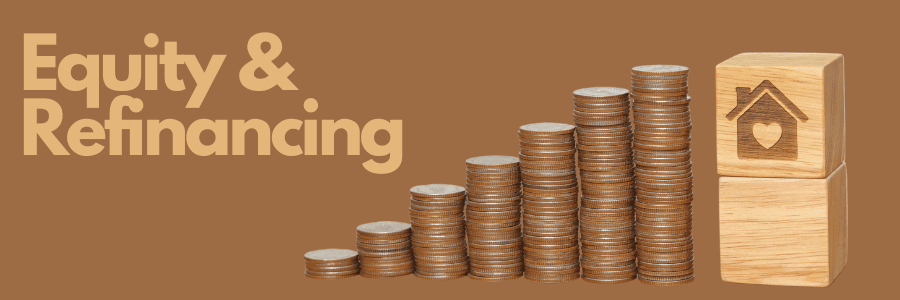Access Your Equity Through Refinancing In 5 Easy Steps!

Table of Contents
If you own a property and have been paying off your mortgage for some time, you may have built up some equity in your home. Equity is the difference between the value of your property and the amount you owe on your loan. You can access this equity by refinancing your home loan, which means changing the terms or conditions of your existing loan or switching to a new lender. Refinancing can help you achieve various financial goals, such as buying a car, renovating your home, or investing in another property.
Equity in your home can benefit you in several ways:
Access to Extra Money: Equity loans allow you to borrow money against the value of your home, which can be used for various purposes such as renovations, debt consolidation, or education costs.
Lower Interest Rates: The funds borrowed are at home loan interest rates, generally lower than other types of credit.
Flexibility: Equity loans offer flexibility as they can be used for almost anything.
Investment Opportunities: Some homeowners access their equity to help fund a renovation, which, if done correctly, can boost a property’s value even more than what is spent. Others use their equity to buy an investment property or shares.
Debt Consolidation: If you have multiple debts, an equity loan can help you consolidate them into one manageable monthly payment.
How To Begin Your Refinancing Journey
Here are some steps you need to take to access equity through refinancing.
Step # 1: Find Out How Much Equity You Have.
You can estimate your equity by subtracting your loan balance from your property value. For example, if your property is worth $700,000 and you owe $400,000 on your loan, your equity is $300,000. However, this differs from the amount you can borrow, as lenders usually require you to keep some equity in your home as a buffer against market fluctuations. A common rule of thumb is that you can borrow up to 80% of your property value without paying lenders mortgage insurance (LMI), an extra cost that protects the lender if you default on your loan. In this case, you could borrow up to $560,000 ($700,000 x 0.8), which means you could access up to $160,000 of equity ($560,000 – $400,000).
Step #2: Decide how you want to use your equity.
You can use your equity for different purposes depending on your financial situation and goals. For example, you can use it to fund home improvements or renovations, which can increase the value and comfort of your home. Alternatively, you can buy a car, go on a holiday, or pay for education or medical expenses. However, remember that these are personal expenses that do not add value to your property, and you will have to pay interest on them over the life of your loan. Another option is to use your equity to buy an investment property, which can generate rental income and capital growth over time. However, this also involves additional costs and risks that you must consider carefully.
Step #3: Compare refinancing options and costs.
Once you have a clear idea of how much equity you have and how you want to use it, you can start looking for refinancing options that suit your needs and budget. You can compare different lenders and products online or consult a mortgage broker to help you find the best deal for your situation. Some factors you need to reach include interest rates, fees, features, flexibility, and customer service. You also need to factor in the costs of refinancing, such as exit fees from your current lender, application fees from your new lender, valuation fees, conveyancing fees, and stamp duty (if applicable).
Step #4: Apply for refinancing and access your equity.
Once you have chosen a refinancing option that meets your requirements, you can apply for it with the new lender. You must provide various documents to prove your income, expenses, assets, liabilities, and identity. The lender will also conduct a credit check and a property valuation to assess your eligibility and borrowing capacity. If your application is approved, you can sign the loan contract and settle the refinancing with the help of a solicitor or conveyancer. The new lender will pay out your existing loan and transfer the remaining funds (your equity) to your nominated account.
Step #5: Use your funds wisely and manage your repayments.
After accessing your equity through refinancing, you can use the funds for your intended purpose. However, remember that accessing equity means increasing your debt and repayments, so use the funds wisely and responsibly. You should also have a plan to manage your repayments and avoid falling behind or defaulting on your loan. You can do this by setting up a budget, tracking your spending, making extra repayments when possible, and reviewing your loan regularly.
The Cost of Unlocking Your Equity
Refinancing is one of the ways to access equity in your home and use it for various purposes. However, it is not a decision that should be taken lightly, as it involves costs that must be weighed against the benefits. Therefore, before refinancing to access equity, you should research, compare different options, seek professional advice, and ensure it aligns with your financial goals and situation.
Some of the costs of refinancing may include:
Application fee: This is a fee charged by the new lender to process your loan application.
Valuation fee: This is a fee charged by the latest lender to assess the value of your property.
Settlement fee: This is a fee charged by the new lender to finalise your loan settlement.
Discharge fee: This is a fee your old lender charges to release your mortgage.
Break fee: This is a fee charged by your old lender if you exit a fixed-rate loan before the end of the term.
Therefore, it is essential to weigh the pros and cons of refinancing and compare different loan options before moving. You can use online tools such as calculators or comparison sites to help you find the best deal for your situation. You can also consult a mortgage broker who can offer expert advice and guide you through refinancing.
Refinancing can be a powerful way to leverage your home equity and improve your financial position. By finding a lower rate, lower repayments and better terms, you can save money, reduce debt and fund your goals. However, refinancing also comes with costs and risks that you must be aware of and plan for. By researching and seeking professional help, you can make an informed decision that suits your needs and circumstances.
At Tiger Finance, we always guide you every step of the way with loan experts well-versed in the current situation in the world of financing. You can get a free consultation with our in-house financing expert without obligation to give you the most accurate picture of your loan situation today.
Contact Tiger Finance today so that we can help you begin your journey to secure the exact hassle-free loan product that you need.
Table of Contents
Find MOre Information

The ABCs of Business Marketing and Caveat Loans
The ABCs of Business Marketing and Caveat Loans Table of Contents Marketing is the process of promoting products or services to other businesses or organisations

Business Owners and Caveat Loans: Why They Fit
Business Owners and Caveat Loans: Why They Fit Table of Contents A business owner owns and operates a commercial enterprise independently or with partners. Business

Optimising Business Finances: Understanding Working Capital and Caveat Loans
Optimising Business Finances: Understanding Working Capital and Caveat Loans Table of Contents Working capital is a crucial indicator of a business’s financial health and operational

Exploring the Advantages and Disadvantages of Caveat Loans
Exploring the Advantages and Disadvantages of Caveat Loans Table of Contents Like many financial options, Caveat loans come with their advantages and disadvantages. Let’s begin

Unlocking Opportunities 3: How Business Owners Can Harness the Power of Caveat Loans
Unlocking Opportunities 3: How Business Owners Can Harness the Power of Caveat Loans Table of Contents Caveat loans, a form of short-term financing, offer business

Unlocking Opportunities 2: How Property Investors Can Harness the Power of Caveat Loans
Unlocking Opportunities 2: How Property Investors Can Harness the Power of Caveat Loans Table of Contents In the fast-paced world of real estate investing, the


